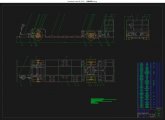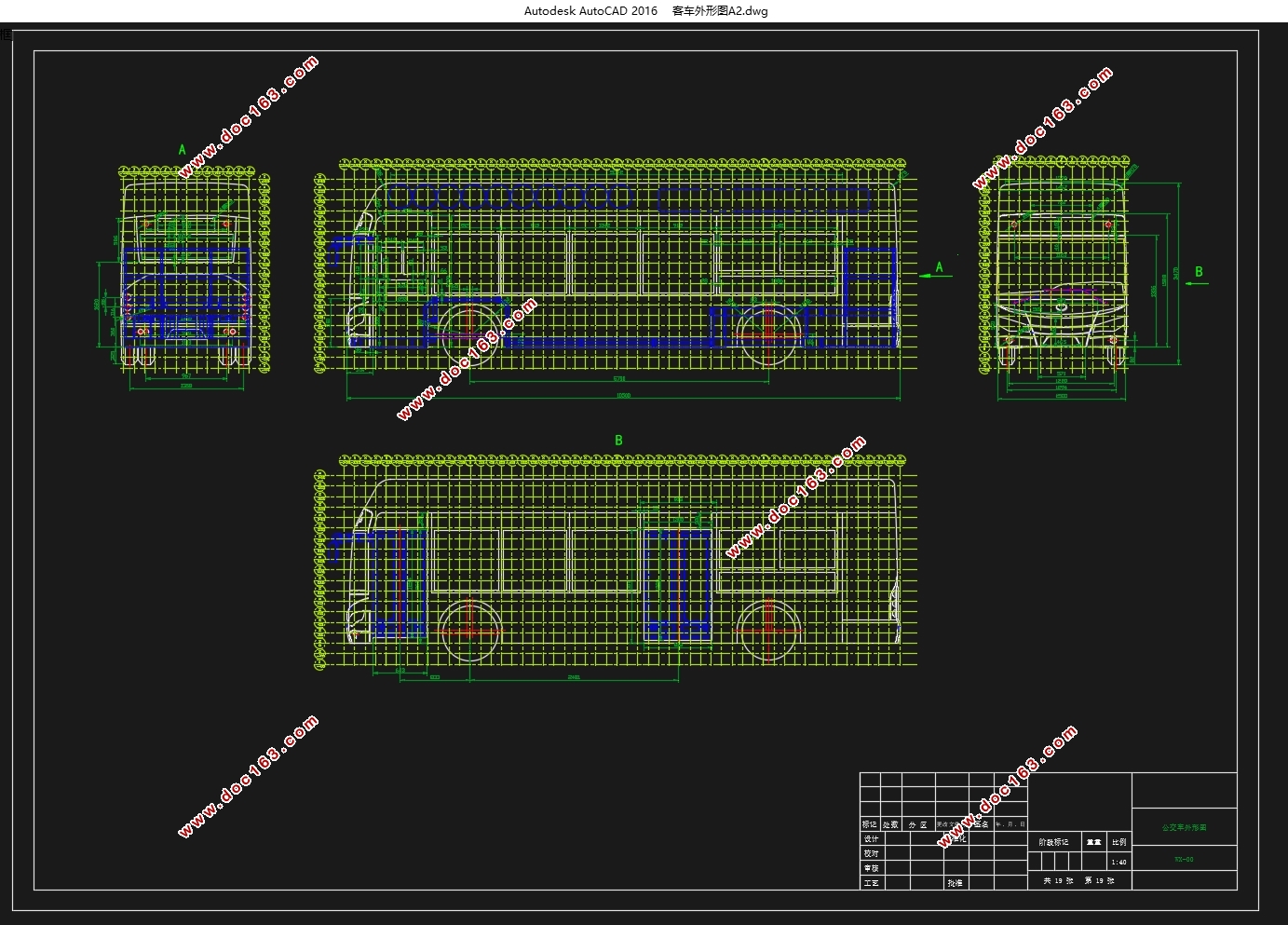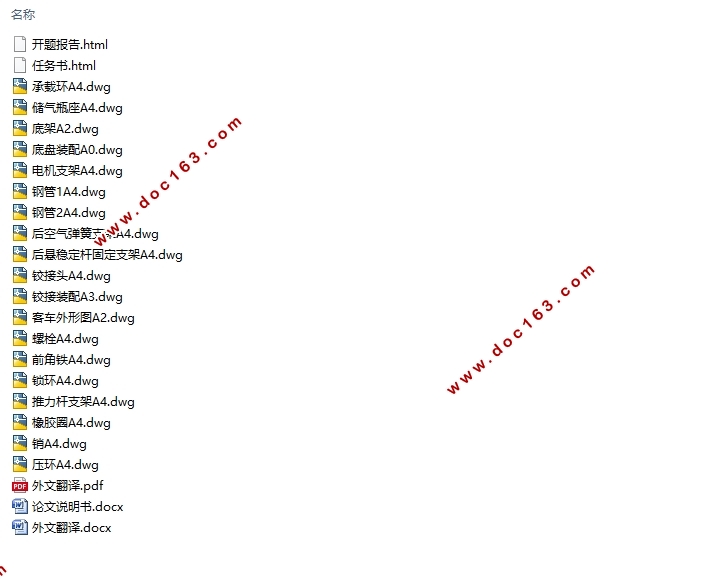燃料电池新能源客车总体设计(含CAD零件图装配图)

燃料电池新能源客车总体设计(含CAD零件图装配图)(任务书,开题报告,外文翻译,论文说明书16800字,CAD图纸17张)
摘要
燃料电池汽车是目前唯一能做到真正“零排放”的新能源汽车,同时在动力性上又能和传统汽车相媲美;然而,燃料电池汽车在续航里程上相比于传统客车还存在着不足,同时,氢气的制备、运输和储存技术还不够成熟且成本较高,加氢站无法大规模建设。基于以上原因,燃料电池汽车更适用于城市公交车。
本文基于对给定的燃料电池公交车的设计要求,对汽车进行了整车参数选型匹配、各系统选型匹配计算、外形选型以及整车底盘的总布置设计。
首先,根据本次设计对燃料电池公交车的设计要求,参考市面上某款成熟的燃料电池公交车的设计,确定了整车的参数,包括空载质量、满载质量、最高车速、轴距、轮距等参数;对燃料电池公交车的外形进行选型,为后续的设计打下基础。
其次,对客车的驱动系统、制动系统、前后悬架、转向系统进行选型匹配计算,重点是驱动系统和制动系统的设计。确定整车的驱动形式、对电机、燃料电池和动力蓄电池等进行选型计算;确定制动系统的形式、对制动系统的制动力矩、制动系统储能供能装置等进行选型计算;对前后悬架、转型系统进行选型。 [资料来源:http://Doc163.com]
最后,在各系统设计完成后,对底盘进行总布置设计,将各系统总成合理地布置在底盘中的适当位置,使其能够正常工作。
本文对燃料电池公交车的整车设计、各系统的选型计算和底盘的布置进行了说明,可以为相关的整车总体设计提供参考。
关键词:燃料电池公交车;总体设计;驱动系统;制动系统;底盘布置
Abstract
Fuel cell buses have the advantage of zero-emissions that other types of passenger cars cannot match. At the same time, they are comparable to traditional bus in terms of dynamics; however, fuel cell buses still have deficiencies in terms of cruising range compared to traditional bus. Meanwhile, The preparation, transportation, and storage technologies of hydrogen are not mature enough and the cost is high. Hydrogenation stations cannot be built on a large scale. Based on the above reasons, fuel cell buses are more suitable for city buses.
This article is based on the design requirements for a given fuel cell bus. The vehicle is selected for vehicle model selection, matching selection for each system selection, shape selection and overall layout of the chassis of the vehicle. [资料来源:https://www.doc163.com]
First of all, according to the design requirements for fuel cell buses in this design, with reference to the design of a mature fuel cell bus in the market, the parameters of the vehicle are determined, including the no-load quality, full-load quality, maximum speed, wheelbase, Wheelbase and other parameters lay the foundation for the design of subsequent systems.
Secondly, the passenger car's drive system, braking system, front and rear suspension, steering system selection and matching calculation, the focus is on the design of the drive system and braking system. Determine the drive form of the vehicle, calculate the selection of the motor, fuel cell, and power battery; determine the form of the brake system, the braking torque of the brake system, the energy storage device of the brake system, etc. ; Selection of front and rear suspensions and transformation systems.
Finally, after the design of each system is completed, the shape of the fuel cell bus is selected; the overall layout of the chassis is designed, and the system assemblies are rationally arranged in the proper position in the chassis so that they can work normally.
This article describes the vehicle design of the fuel cell bus, the selection calculation of each system, and the layout of the chassis, which can provide reference for the overall design of the relevant vehicle.
Key Words:fuel cell bus; overall design; drive system; brake system; chassis layou
在进行燃料电池客车整车和各个系统参数选择之前,要明确燃料电池客车的设计任务要求。本文燃料电池客车为在城市运行的城市公交车,初始要求数据如下:
表2.1 整车初始数据要求
车辆总长 10~12m
车辆总质量 <16500kg
最高车速 >70km/h
一次充气续航里程 >350km
本次设计在参考目前市面上的某款成熟的燃料电池客车,结合自身实际情况,选择整车参数如下表:
表2.2 整车参数选择
总质量 16500kg
整备质量 12500kg
尺寸参数 10500×2500×3470mm
轴荷分配(空载) 4200/8300
[资料来源:www.doc163.com]
轴荷分配(满载) 5950/10550
轴距 5700mm
前后悬 2300/2500m
离地高度 320mm
最高车速 70km/h
前轮距 2070mm
后轮距 1860mm
质心高度(空载) 1500mm
质心高度(满载) 1300mm
轮胎规格 295/80R22.5
滚动阻力系数 0.014
传动效率 ≈1
Cd 0.65
最大爬坡度 25%
加速时间 0-50km/h<28s(满载)
最小转弯半径 11m
[资料来源:Doc163.com]




目录
毕业设计 1
摘要 2
Abstract 3
第一章绪论 1
1.1汽车总体设计的目的及意义 1
1.2国内外部分相关企业燃料电池客车发展状况 1
1.3国内外部分相关课题研发状况 2
1.4从技术和市场的角度分析本次设计的必要性和可行性 2
第二章整车参数选择 4
第三章燃料电池电动客车驱动系统选型及参数匹配 7
3.1燃料电池动力系统选型: 7
3.2燃料电池动力系统部件选型 9
3.2.1燃料电池类型选择 9
3.2.2电动机类型选择 10
3.2.3蓄电池类型选择 11
3.3燃料电池驱动系统参数匹配 13
3.3.1电机参数匹配 13
3.3.2燃料电池参数匹配 16
3.3.3蓄电池参数匹配 18
第四章制动系统总体设计 19
4.1制动系统理论计算 19
[资料来源:http://www.doc163.com]
4.2制动系统储能及供能装置参数计算 23
4.2.1储气筒容积计算 24
4.2.2空压机参数计算 25
4.3制动能量回收策略 27
第五章转向系统及前后悬架总体设计 28
5.1转向系统概述 28
5.2燃料电池客车转向系统选择 28
5.2.1机械式转向系统评价 29
5.2.2液压助力式转向系统评价 29
5.2.3电控液压助力转向系统评价 29
5.2.4电动助力转向系统评价 30
5.3悬架概述 30
5.4空气悬架简介 30
第六章操纵稳定性及通过性评估 32
6.1操纵稳定性评估 32
6.2通过性评估 34
第七章全文总结 36
参考文献 38
附录 matlab及simulink程序 40
致谢 43
[版权所有:http://DOC163.com]
下一篇:基于CAN总线的混合动力汽车电气驱动控制系统设计(含CAD图)
